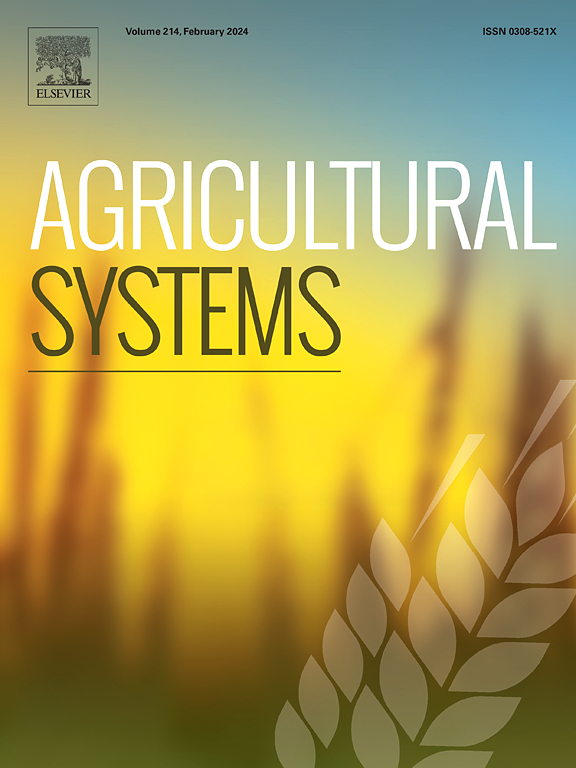Performances of conventional and organic livestock development scenarios in France through nitrogen flow analysis
IF 6.1
1区 农林科学
Q1 AGRICULTURE, MULTIDISCIPLINARY
引用次数: 0
Abstract
CONTEXT
Organic agriculture (OA) is promoted in the European Union (EU) as a sustainable form of agriculture. However, its expansion may be limited by its dependence on external nitrogen (N) resources, such as conventional manure and imported feed, as it prohibits the use of industrial fertilisers. There is currently no consensus on the role of livestock in scenarios of OA expansion, despite their critical contribution to increasing soil fertility through grazing and nutrient cycling via manure and urine.
OBJECTIVE
Here, we explored the expansion of OA with a view to having 25 % of total agricultural land under OA by 2030, as defined by the EU Green Deal policy, using two development pathways for organic and conventional livestock: business as usual (BAU) and halving the number of livestock (HL).
METHODS
We modelled N flows for organic, conventional and the entire agricultural system using an existing N budget model applied at the national scale for France.
RESULTS AND CONCLUSIONS
The results indicated that changing the numbers of livestock species when expanding OA influences N availability. Transitioning to 25 % of agricultural land under OA along with increasing the number of organic livestock in the BAU and HL scenarios decreased total N input, especially industrial fertiliser and feed imports, by 9 % and 28 %, respectively, while decreasing N surpluses by 9 % and 26 %, respectively. In parallel, in the BAU and HL scenarios, biological N fixation increased by 32 % and 61 %, respectively, N output in animal and crop products decreased by 9 % and 30 %, respectively, due to the lower productivity of organic livestock and crops. Notably, this transition implied decreasing human consumption of animal products in the BAU and HL scenarios by 5 % and 30 %, respectively. The scenarios demonstrated the key contribution of livestock and biological N fixation of legumes to the expansion of OA, but further analysis is required, such as considering changes in human diets, farming practices or land use.
SIGNIFICANCE
This study highlights simultaneous trade-offs of two agricultural systems at the national scale.

通过氮流分析法国传统和有机畜牧业发展方案的性能
有机农业(OA)作为一种可持续的农业形式在欧盟(EU)得到推广。然而,由于它禁止使用工业肥料,它的扩张可能会受到限制,因为它依赖外部氮资源,例如常规粪肥和进口饲料。尽管牲畜通过放牧和粪便和尿液中的养分循环对提高土壤肥力做出了重要贡献,但目前还没有就牲畜在OA扩大情景中的作用达成共识。在这里,我们探索了OA的扩展,以期到2030年,按照欧盟绿色协议政策的定义,OA占总农业用地的25%,采用有机和传统牲畜的两条发展途径:照常营业(BAU)和牲畜数量减半(HL)。方法:我们利用现有的在法国全国范围内应用的氮预算模型,对有机、传统和整个农业系统的氮流进行了建模。结果与结论在扩大OA的同时,改变畜种数量会影响氮素有效性。在BAU和HL情景下,随着有机牲畜数量的增加,OA情景下向25%的农业用地过渡,总氮投入(特别是工业肥料和饲料进口)分别减少了9%和28%,氮盈余分别减少了9%和26%。与此同时,在BAU和HL情景下,由于有机牲畜和作物生产力下降,动物和作物产品的氮产量分别下降了9%和30%,生物固氮量分别增加了32%和61%。值得注意的是,这一转变意味着在BAU和HL情景下,人类对动物产品的消费量分别减少5%和30%。这些情景证明了牲畜和豆科植物的生物固氮对OA扩展的关键贡献,但需要进一步分析,例如考虑人类饮食、耕作方式或土地利用的变化。意义本研究强调了在国家尺度上两种农业系统的同步权衡。
本文章由计算机程序翻译,如有差异,请以英文原文为准。
求助全文
约1分钟内获得全文
求助全文
来源期刊

Agricultural Systems
农林科学-农业综合
CiteScore
13.30
自引率
7.60%
发文量
174
审稿时长
30 days
期刊介绍:
Agricultural Systems is an international journal that deals with interactions - among the components of agricultural systems, among hierarchical levels of agricultural systems, between agricultural and other land use systems, and between agricultural systems and their natural, social and economic environments.
The scope includes the development and application of systems analysis methodologies in the following areas:
Systems approaches in the sustainable intensification of agriculture; pathways for sustainable intensification; crop-livestock integration; farm-level resource allocation; quantification of benefits and trade-offs at farm to landscape levels; integrative, participatory and dynamic modelling approaches for qualitative and quantitative assessments of agricultural systems and decision making;
The interactions between agricultural and non-agricultural landscapes; the multiple services of agricultural systems; food security and the environment;
Global change and adaptation science; transformational adaptations as driven by changes in climate, policy, values and attitudes influencing the design of farming systems;
Development and application of farming systems design tools and methods for impact, scenario and case study analysis; managing the complexities of dynamic agricultural systems; innovation systems and multi stakeholder arrangements that support or promote change and (or) inform policy decisions.
 求助内容:
求助内容: 应助结果提醒方式:
应助结果提醒方式:


